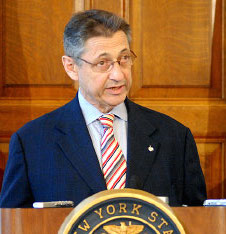
After tweaking a few of their house rules and adopting a state budget on time for the first time in 20 years, many New York State legislators would have you believe they’ve fixed all or most of what’s broken in Albany.
Don’t believe it. Chronically late budgets were only one symptom of much deeper, more pervasive problems.
The lack of openness and accountability in the state Capitol remains as striking as ever. So does the paucity of debate on matters large and small. But yet another concern, which receives less attention than it deserves, is the sheer cost and inefficiency of the place.
Pegged at $208 million in the new fiscal year, the Legislature’s budget now runs to nearly $1 million for each New York State senator and assemblyman. On a per-member basis, New York’s expenditures are three times the national average, trailing only California and roughly tied with Pennsylvania.
The budget is driven by two factors: salaries and staffing.
New York legislators receive base pay of $79,500 a year, second only to California’s $99,000, including the same generous level of guaranteed pension and post-retirement health benefits available to all public employees. At the discretion of the Senate majority leader and Assembly speaker, New York members also can receive leadership stipends (or “lulus”) of at least $8,000, plus $140 in expenses for each day in Albany. The national average for all salaried state legislators is just over $31,000 a year.
Supporting New York’s legislators are roughly 3,700 employees, including the nation’s largest full-time state legislative staff – who are distributed very unevenly among members and central committee and “conference” functions. In both houses, senior members of the majority get the most and junior members of the minority get the least.
Politically “marginal” members receive extra staff support and other added help – which, along with gerrymandering of the district map, helps to ensure that no incumbent legislator is ever truly “marginal” at all.
So what do they do to justify it all? For one thing, they churn out bills – 16,892 in 2002 alone, which was more than twice the amount in the next most prolific state legislature. Fortunately, only a very small percentage are ever enacted.
Here are three reforms that could save money while simultaneously empowering members:
Tightly limit bill introductions. Thirty or so bills per member per session should be more than enough to address the needs of New Yorkers.
Equalize the distribution of member budgets and staff resources while reducing the number of superfluous central staff.
Eliminate lulus. All members should receive the same salary and the same basic staff allotment, regardless of seniority or party affiliation.
As for the level of the salary, that has been the subject of considerable debate over the years.
Some (such as Syracuse University Professor Grant Reeher, writing in this space) have argued that a better-paid, officially full-time Legislature would do a better job. But given the recent performance of Albany’s already well-compensated, virtually full-time lawmakers, many New York taxpayers may understandably find themselves more attracted to the opposite approach.






